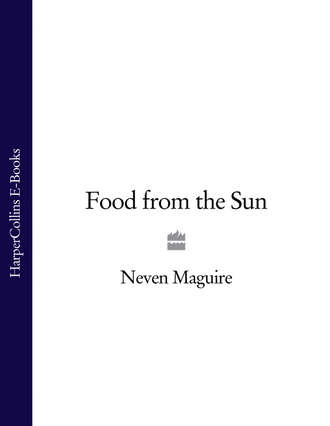
Полная версия
Food from the Sun
Poultry
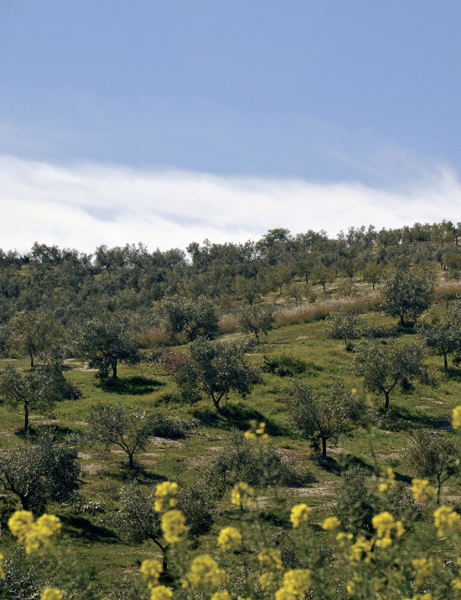
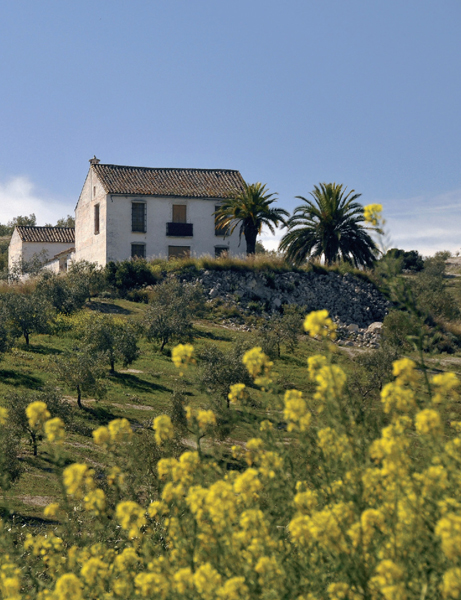
Turkey Moussaka
Serves 6–8
175ml (6fl oz) olive oil, for cooking
1 large onion, peeled and finely chopped
3 garlic cloves, peeled and finely chopped
750g (1 34lb) lean minced turkey
175ml (6fl oz) white wine 14 tsp ground cinnamon
14 tsp ground allspice
1 tbsp chopped fresh oregano
2 bay leaves
1 tsp fresh thyme leaves
2 x 400g cans of chopped tomatoes
4 medium aubergines plain flour, for dusting
salt and freshly ground black pepper
Chunky Greek Salad, to serve (see page 111)
For the cheese sauce
75g (3oz) unsalted butter
75g (3oz) plain flour
900ml (112 pints) milk
75g (3oz) Parmesan cheese, freshly grated
100g (4oz) Gruyère cheese, grated
1 egg, plus 2 egg yolks
Moussaka is a Greek dish made up of layers of minced lamb and aubergine, covered with a cheese sauce. Here, I’ve used turkey instead, which is economical and quite low in fat, but you could always make it the traditional way if you prefer. There are a few stages to the recipe, so it is best prepared in advance and then cooked just before serving.
Heat 2 tablespoons of olive oil in a large flameproof casserole dish. Add the onion and cook gently for 6–8 minutes, stirring at intervals. Stir in the garlic and cook for another 2–3 minutes, stirring occasionally, until the onion is softened but not browned.
Put a little olive oil in a frying pan set over a fairly high heat, then tip in half the minced turkey. Cook until lightly browned, breaking up any lumps with a wooden spoon, then empty onto a plate. Repeat until all of the turkey is cooked, then deglaze the pan by adding just a little white wine and scraping the base of the pan with a wooden spoon to loosen any sediment, allowing the liquid to simmer until it has reduced slightly.
Stir the cinnamon, allspice, oregano, bay leaves and thyme into the casserole dish with the onion mixture and cook for about a minute, stirring. Add the cooked turkey and the reduced wine, along with the remaining wine and the chopped tomatoes. Bring to the boil, then lower the heat and simmer for 45–50 minutes until the turkey has broken right down and the liquid has reduced.
Meanwhile, cut the aubergines into slices 1cm (12 in) in thickness and layer them up in a colander, sprinkling with salt between each layer. Set aside on the draining board for 30 minutes to allow the salt to draw out any bitter juices.
To make the cheese sauce, melt the butter in a large non-stick saucepan set over a low heat and stir in the flour. Remove the pan from the heat and gradually whisk in the milk, then return to the heat and cook for 6–8 minutes, stirring continuously, until the sauce is smooth and thick. Remove from the heat again and stir in 50g (2oz) of Parmesan and 50g (2oz) of Gruyère until melted.
Add salt and pepper and allow to cool slightly, then whisk in the egg and egg yolks to combine.
Set a large frying pan over a high heat. Rinse the aubergines under cold running water and pat dry with kitchen paper. Dust the aubergine slices with flour. Add a couple of tablespoons of olive oil to the frying pan and fry the dusted aubergine slices in batches for 8–10 minutes, turning once, until cooked through and golden. Replenish the oil for each new batch. Drain the cooked slices on kitchen paper. You are now ready to construct the moussaka.
Preheat the oven to 180°C (350°F), gas mark 4. Spoon a third of the turkey mixture (discarding the bay leaves) into the base of an ovenproof dish measuring about 30 x 20cm (12 x 8in). Cover with half of the aubergine slices. Repeat the layers, finishing with a layer of the turkey mixture, then pour over the cheese sauce. Sprinkle the remaining Parmesan and Gruyère on top and bake for 50–60 minutes, until bubbling and golden brown. Allow the moussaka to settle for 5 minutes before cutting into squares and arranging on warmed plates with the chunky Greek salad.
Spicy Chicken and Mango Noodles
Serves 4
450g (1lb) skinless chicken fillets
100g (4oz) vermicelli rice noodles
1 red onion, peeled and thinly sliced
small bunch of fresh coriander
handful of fresh mint leaves
1 ripe mango, peeled, stone discarded and cut into fine strips
4 tbsp roughly chopped toasted cashew nuts
For the marinade
1 tbsp dark soy sauce
1 tbsp sweet chilli sauce
juice of 12 lime
1 tsp mild curry powder
1 garlic clove, peeled and crushed
pinch caster sugar
2 tbsp torn fresh basil leaves
2 tbsp sunflower oil
For the dressing
1 tsp caster sugar
2 tbsp dark soy sauce
1 tbsp sweet chilli sauce juice of 1 lime
4 tbsp sunflower oil
This quick light salad is perfect for eating alfresco, whether you decide to cook the chicken under the grill or on a barbecue. Tiger prawns would make a nice alternative to the chicken.
Place all the ingredients for the marinade in a non-metallic bowl and mix well to combine. Cut the chicken fillets into 3cm (1 1/4in) strips and stir in to the marinade. Cover with clingfilm and chill for at least 2 hours or overnight to allow the flavours to penetrate the chicken.
To make the dressing, dissolve the sugar in the soy sauce in a small bowl, then whisk in the sweet chilli sauce, lime juice and sunflower oil.
Place the vermicelli noodles in a large bowl and cover with boiling water. Leave for about 5 minutes until softened or according to the packet instructions.
Put the red onion slices in a bowl of iced water for 2–3 minutes –this will make them crisp and will tone down the flavour a little.
Drain both the vermicelli and red onion well and place together in a large bowl. Tear the coriander and mint leaves away from their stalks and add to the bowl along with the mango strips and cashew nuts.
Preheat the grill to high. Shake any excess marinade from the chicken strips and place the meat on a foil-lined grill rack. Cook for 5 minutes, turning once or twice.
To serve, add the cooked chicken and the dressing to the bowl with the noodles and toss until well combined.
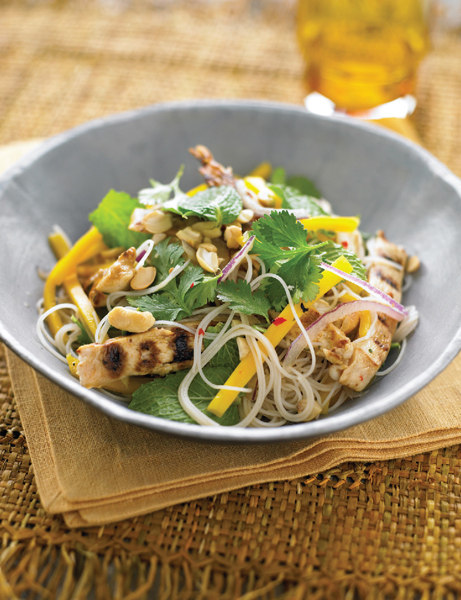

Blackened Chicken with Roasted Red Pepper and Avocado Salsa
Serves 4
1 tsp chilli powder
1 tsp sweet paprika
1 tsp garlic salt (optional)
1 tbsp chopped fresh thyme
1 tbsp chopped fresh flat-leaf parsley, plus extra sprigs to garnish
4 tbsp olive oil
4 x 200g (7oz) large skinned chicken breast fillets, at room temperature
salt and freshly ground black pepper
For the salsa
1 large red pepper
1 tbsp chilli oil (see page 219 or shop-bought)
1 garlic clove, peeled and crushed
1 medium-hot red chilli, seeded and finely chopped
juice of 1 lime
1 tbsp chopped fresh mixed herbs (such as coriander and parsley)
1 ripe avocado
This dish is a favourite of mine during barbecue season. If you make a double quantity of the spice mixture and keep it in an airtight container in the fridge for a week or two, you’ll be ready to marinate any meat that you are grilling. The salsa also tastes great with grilled or barbecued fish.
Mix together the chilli powder, paprika, garlic salt (if using), thyme and parsley with half the olive oil in a shallow non-metallic dish. Add 2 teaspoons of black pepper and half a teaspoon of salt to season. Add the chicken breasts and rub the mixture into the flesh. Leave for a couple of hours or, if time allows, cover with clingfilm and chill overnight to let the flavours penetrate the flesh.
To roast the pepper for the salsa, preheat the oven to 220°C (425°F), gas mark 7 and roast the pepper in a small tin for 20–25 minutes until the skin is black. Alternatively, spear the stalk end of the pepper on a fork and hold over the flame of a gas hob, turning regularly until the skin has blistered and blackened, or scorch the pepper with a chef’s blowtorch. Leave to cool and then break in half and remove the stalk, skin and seeds; discard. Cut the flesh into small dice and place in a bowl.
Preheat the grill to high. Arrange the chicken fillets on the grill rack and cook for about 8 minutes on each side, basting with the remaining oil until the chicken is lightly charred and just tender (you could also cook these on a barbecue or griddle pan).
To finish the salsa, put the chilli oil, garlic and red chilli into a small frying pan and, as soon as it starts to sizzle, pour it onto the roasted red pepper mixture, stirring to combine thoroughly. Add the lime juice and herbs and season with salt and pepper. Cut the avocado in half and peel off the skin, then dice the flesh, discarding the stone. Fold into the salsa and set aside.
Transfer the rested blackened chicken to a chopping board and slice on the diagonal. Arrange on plates with the roasted red pepper and avocado salsa. Garnish with the parsley sprigs to serve.
Chicken and Broad Bean Paella with Clams
Serves 6-8
1.2 litres (2 pints) chicken stock (see page 215)
12 tsp saffron strands, soaked in a little warm water
about 120ml (4fl oz) olive oil
175g (6oz) raw chorizo, peeled and thinly sliced
100g (4oz) pancetta, diced
8 skinless, boneless chicken thighs, well trimmed and each cut in half
2 garlic cloves, peeled and finely chopped
1 large Spanish onion, peeled and finely diced
1 red pepper, seeded and diced
1 tsp fresh thyme leaves
12 tsp dried chilli flakes
425g (15oz) Spanish short-grain rice (such as Calasparra)
1 tsp sweet paprika
120ml (4fl oz) dry white wine
350g (12oz) fresh broad beans, podded and shelled
4 ripe vine tomatoes, peeled, seeded and diced
18 large clams (such as palourde), cleaned
2 tbsp chopped fresh flat-leaf parsley
salt and freshly ground black pepper
This is one-pot dining at its best, and looks very special cooked in a paellera (the traditional paella dish). I brought one home from Spain a number of years ago and, despite lots of use, it is still in perfect condition.
Put the stock and saffron in a large saucepan set over a high heat and bring to the boil. Then turn the heat down to keep the stock warm but not boiling. Heat half the olive oil in a paella dish or large, heavy-based sauté or frying pan. Add the chorizo and pancetta and fry for a few minutes until crisp and lightly golden, then transfer to a plate and set aside. Put the chicken pieces in the pan and fry for a few minutes on each side until golden; remove and set aside with the chorizo and pancetta.
Add half the remaining olive oil to the pan. Add the garlic, onion and pepper and cook for a few more minutes, stirring at intervals.
When the vegetables have softened but not browned, add the thyme, chilli flakes and rice to the pan and stir for about 2 minutes or until all the grains of rice are nicely coated and glossy. Stir in the paprika, then pour in the wine and allow it to bubble a little. Pour in the hot, saffron-infused chicken stock, then stir in the cooked chorizo, pancetta and chicken thighs and cook for about 5 minutes, stirring occasionally.
Fold in the broad beans and tomatoes and season with salt and pepper. Place the clams on top of the paella so that they will open facing upwards and continue to cook gently for another 10–15 minutes or until the rice is just tender. Discard any clams that have not opened. Remove from the hob and leave the paella to rest in a warm place for 10 minutes. Garnish with the parsley and serve straight from the paella dish.
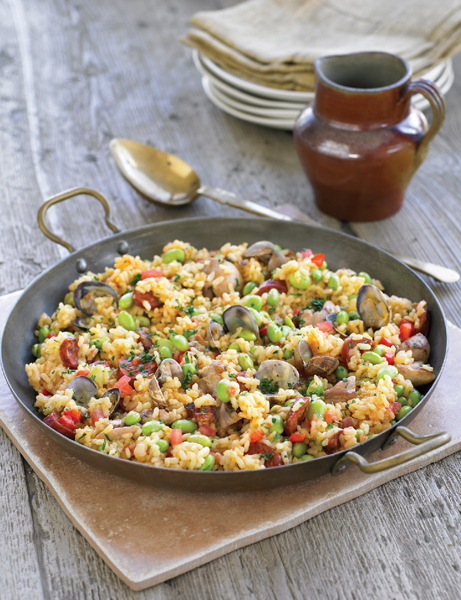
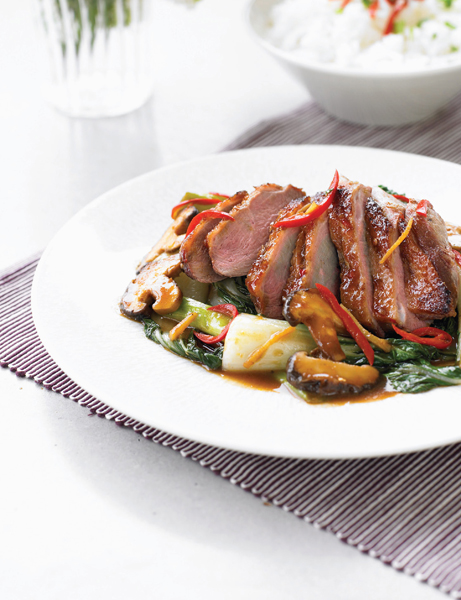
Tea-smoked Barbary Duck
Serves 4
50g (2oz) loose jasmine tea leaves
50g (2oz) light muscovado sugar
50g (2oz) long-grain rice
4 x 225g (8oz) Barbary duck breasts, well trimmed, skin left on
4 tsp sesame oil
1 tbsp hoisin sauce
1 tsp sweet chilli sauce
1 tsp dark soy sauce
jasmine rice and Stir-fried Baby Pak Choi with Mushrooms (see page 128), to serve
spring onion, shreds of red chilli, to garnish the rice
Barbary duck is far less fatty than traditional English duck. For a really special occasion you could even experiment with game, such as guinea fowl or pheasant, for this recipe.
Scrunch the sides of a foil circle to make a container about 12.5cm (5in) in diameter. Mix the tea, sugar and rice, pour into the foil dish and place in the base of a wok with a tight-fitting lid. Using a sharp knife, lightly criss-cross the skin of each duck breast. Brush each one all over with a teaspoon of sesame oil and arrange on a rack that will fit in the wok. Don’t yet put the rack into the wok.
Place the wok (containing the tea) over a very high heat. When the tea starts smoking, add the rack of duck breasts. Cover with the lid and leave on the heat for 10 minutes. Don’t be tempted to look under the lid as the smoke will disperse and the duck won’t cook. If lots of smoke is escaping into your kitchen, or your smoke alarm goes off, turn the heat down a little.
After 10 minutes, remove the wok from the heat but still don’t lift the lid. Let it cool for 5 minutes and the smoke to dissipate slowly, then transfer the duck to a plate and allow to cool completely. It is now smoked and just needs a final cooking.
Preheat the oven to 200°C (400°F), gas mark 6. Heat a large ovenproof frying pan over a moderate heat. When the pan is hot, add the duck breasts, skin-side down, and cook for 1–2 minutes until the skin is crisp and golden brown.
Meanwhile, mix together the hoisin, sweet chilli and soy sauce in a small bowl. Remove the pan from the heat and drain off the excess fat. Brush the fillet side of each breast with a teaspoon of the hoisin mixture, then turn the fillets over so that they are skin-side up. Transfer the pan to the oven and cook for another 5–6 minutes if you like your duck pink, a bit longer for well done.
Leave the duck to rest for a couple of minutes, then carve each breast on the diagonal and fan out on hot plates. Serve with a mound of pak choi and a bowl of jasmine rice. Scatter the rice with the spring onions and chilli shreds.
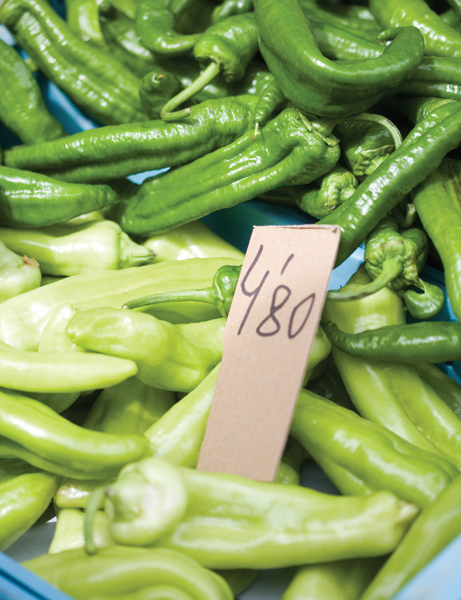
Creamy Chicken Korma
Serves 4
2 tbsp sunflower oil
2 onions, peeled and finely chopped
2 garlic cloves, peeled and crushed
2 tsp finely grated root ginger
1 green chilli, seeded and finely chopped
1 tsp garam masala
1 tsp ground turmeric
14 tsp chilli powder
400g can of chopped tomatoes
1 tsp tomato purée
4 boneless skinless chicken breasts, cut into 2.5cm (1 in) cubes
150ml (5fl oz) double cream
salt and freshly ground black pepper
2 tbsp roughly chopped fresh coriander, to garnish
basmati rice, warmed naan bread and mango chutney, to serve
This authentic recipe from my good friend Naseem Booth is one that I return to again and again. Curries always taste better when they have been kept for a day or two. This one will keep quite happily in the fridge for two days, and also freezes very well.
Heat the oil in a large saucepan and fry the onions and garlic until for about 10 minutes until golden brown. Stir in the ginger and green chilli and cook for 1 minute, stirring.
Add the garam masala to the pan with the turmeric, chilli powder and a pinch of salt and cook for another minute, stirring. Add the tomatoes, tomato purée and 150ml (5fl oz) of water, stir well to combine, then reduce the heat and simmer for 20–25 minutes, stirring occasionally, until the sauce is so well reduced that it is almost sticking to the bottom of the pan and the oil has separated out on the surface.
Add the chicken to the sauce with a few tablespoons of water. Slowly bring to the boil, then reduce the heat and simmer gently with the lid on for about 20 minutes or until the chicken is cooked through and completely tender. Stir in the cream and simmer gently for a few more minutes until well combined. Season with salt and pepper.
To serve, spoon basmati rice and chicken korma onto warmed plates and scatter over the coriander. Place the naan breads in a separate serving dish to pass around with the mango chutney.
Butterflied Poussin
Serves 4–6
1 tbsp mixed peppercorns
4 poussins, butterflied (ask your butcher or see method for instructions)
4 large garlic cloves, peeled and finely chopped
finely grated rind of 2 large oranges
2 handfuls of fresh basil leaves
4 spring onions, trimmed and finely chopped
1 red chilli, seeded and finely chopped
2 tbsp clear honey
2 tbsp fino (dry) sherry
150ml (5fl oz) olive oil
salt and freshly ground black pepper
lightly dressed green salad, to serve
8 metal skewers (23cm (9in) in length)
Poussins are the smallest type of chicken you can buy. I like them because they are tender and quick to cook but you could use any type of chicken pieces instead. As the poussin cooks it will blacken in places, resulting in a well-flavoured, crisp skin and moist, tender meat underneath.
Place the peppercorns in a small frying pan and toast for a few minutes, tossing occasionally, until aromatic. Grind to a powder in a mini blender or with a pestle and mortar, then set aside.
If your butcher hasn’t already butterflied the poussins, use poultry shears or kitchen scissors to cut each poussin down both sides of the backbone, then remove and discard the bone. Snip the wishbone in half, open out the poussin, then snip out the ribs. Turn skin-side up, and press down firmly on the breastbone with the heel of your hand to flatten out. Trim off any excess skin, wash under cold running water and pat dry with kitchen paper.
Place the garlic, ground peppercorns, orange rind, basil, spring onions and chilli in a mini blender or pestle and mortar and work into a smooth paste. Transfer to a large plastic container with a lid and add the honey, sherry and olive oil. Season with salt and pepper and stir until well combined. Add the butterflied poussins and turn to coat them thoroughly in the mixture, then secure the lid and leave to marinate in the fridge for at least 4 hours or preferably overnight, shaking the container occasionally.
When ready to cook, either preheat the grill to medium–hot or the oven to 220°C (425°F), gas mark 7. Thread two metal skewers in a criss-cross fashion through each butterflied poussin, wiping off any excess marinade. This keeps them flat during cooking – it also makes them easier to handle when hot.
Arrange the poussins on a grill pan or a large roasting tin with a wire rack, and cook for 10–15 minutes on each side until cooked through and golden brown, basting occasionally with the leftover marinade. Leave to rest for a few minutes, then remove the skewers and arrange on warmed plates with some green salad.
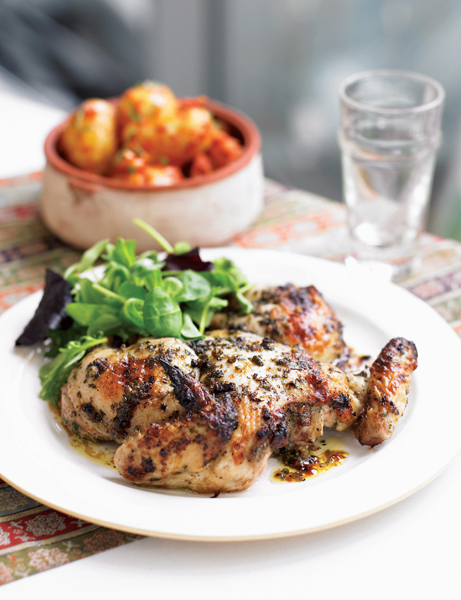
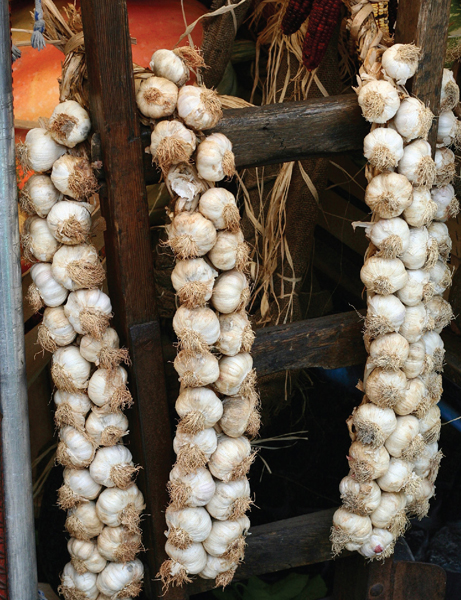
Vietnamese-style Grilled Five-spice Chicken Thigh Salad
Serves 4
6 garlic cloves, peeled and sliced
1 large shallot, peeled and roughly chopped
1 tbsp minced or chopped fresh root ginger
4 tsp caster sugar
4 tbsp dark soy sauce
4 tbsp Thai fish sauce (nam pla) or light soy sauce
12tsp Chinese five-spice powder
8 chicken thighs, with skin
2 tbsp sunflower oil
100g (4oz) green beans, trimmed and sliced into 2.5cm (1 in) lengths
275g (10oz) mixed salad leaves
1 small red pepper, halved, seeded and diced
225g (8oz) cherry plum tomatoes, halved or quartered
2–3 tbsp vinaigrette (see page 85)
salt and freshly ground black pepper
very fine shreds of carrot and long thin fresh chives, to garnish
Chicken thighs are not only cheaper than breasts but they can result in a much tastier dish. The secret of this recipe is in the slow cooking, which would leave a breast fillet tasteless and dry. When using thighs, you end up with crispy skin and succulent, well-flavoured flesh.
To make the marinade, place the garlic in a mini blender or a pestle and mortar, along with the shallot, ginger and sugar, then work to a paste. Transfer to a small bowl and whisk in the soy sauce, Thai fish sauce, five-spice powder and several grinds of black pepper.
Arrange the chicken thighs in a shallow, non-metallic dish and pour over the marinade, turning the meat until well coated. Cover and chill for at least 2 hours or up to 24 hours for best results, turning the chicken thighs several times in the marinade. Bring back to room temperature before cooking and wipe off any excess marinade with kitchen paper.
Heat a frying pan over a medium heat. Put the oil in the pan, then add the chicken thighs skin-side down. Cook for 20–30 minutes until the skin is golden and crispy. Don’t be tempted to touch them while they are cooking or to shake the pan – just leave them alone and they will cook beautifully.





